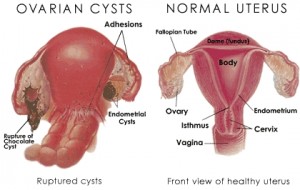(ThyBlackMan.com) Ovarian cysts are small, fluid-filled sacs that can develop with a woman’s ovaries. Although most ovarian cysts are benign and will disappear on their own, their spontaneous rupture can be painful and sometimes necessitate medical treatment.
When do they occur?
Ovarian cysts are most likely to occur during the childbearing years, and the majority of these types of cysts are benign (non-cancerous). Women with ovarian cysts who are past the age of menopause are known to be at a higher risk for developing ovarian cancer.
What are the common forms of ovarian cysts?
The most common types of ovarian cysts are known as functional cysts.
One type of functional cyst is known as a follicle cyst, and these occur when the sac containing an unfertilized egg does not break open to release the egg. The cyst continues to grow and eventually disintegrates on its own within  several months.
several months.
The second type of functional cyst is known as a corpus luteum cyst. In this situation, the sac releases the egg but the sac seals itself following the release of the egg and begins to fill with fluid. Corpus luteum cysts have been known to grow to 3 or 4 inches in diameter and can be quite painful. Certain medications used to encourage ovulation may predispose some women to developing corpus luteum cysts.
Are there other types of ovarian cysts?
There are four other types of ovarian cysts .
Endometriomas: These ovarian cysts form in women who have underlying endometriosis. They are most often painful during menstruation and intercourse.
Cystadenomas: These care cysts that form on the outer surface of the ovary, and may be painful.
Polycystic ovaries: This condition occurs when eggs mature within their sacs but are never released from the ovaries. More and more cysts form and grow, and the ovaries then contain many of these fluid-filled cysts. Polycystic ovary syndrome has many symptoms and necessitates further investigation and potential treatment.
Dermoid cysts: These cysts can become quite large, and may contain many types of cells, including hair and teeth. They are not humanoid in any way, but the notion of a cyst with hair, teeth and other tissues growing within a woman’s body can be disconcerting.
What are the symptoms?
Some ovarian cysts cause no symptoms whatsoever and will resolve spontaneously. Others will cause various symptoms and necessitate treatment and symptom management. Potential symptoms include, but are not limited to:
- Pressure or pain in the abdomen
- Nausea and vomiting
- Abdominal bloating
- Fever
- Abnormal uterine bleeding
- Low back pain
- Weight gain
- Tenderness of the breasts
- Difficulty emptying the bladder
Severe and sudden pain in the abdomen and pelvis require immediate medical attention, especially if accompanied by nausea and vomiting, faintness, weakness, dizziness or fever
How are they diagnosed?
Ovarian cysts are usually found during an ultrasound of the pelvis, or may be manually felt during a gynecological exam. Blood tests can be done to determine the presence of cancer, and an ultrasound helps physicians to understand the size and shape of the cyst(s). Hormone blood tests may also be ordered.
What is the treatment?
Many cysts are simply watched closely without invasive action to remove them, especially in women of childbearing age who have fluid-filled cysts and no symptoms. Cysts can be removed surgically when very painful, very large, or determined to be cancerous or likely to be cancerous. For women who produce multiple and frequent functional cysts, birth control pills are sometimes prescribed to halt ovulation and the formation of new cysts.
Can they be prevented?
Ovarian cysts cannot be prevented but many resolve on their own without treatment or intervention. However, if you have persistent pelvic pain or any of the symptoms mentioned above, it is wise to see your physician or women’s health specialist for an exam.
Written By Keith Carlson

















Leave a Reply